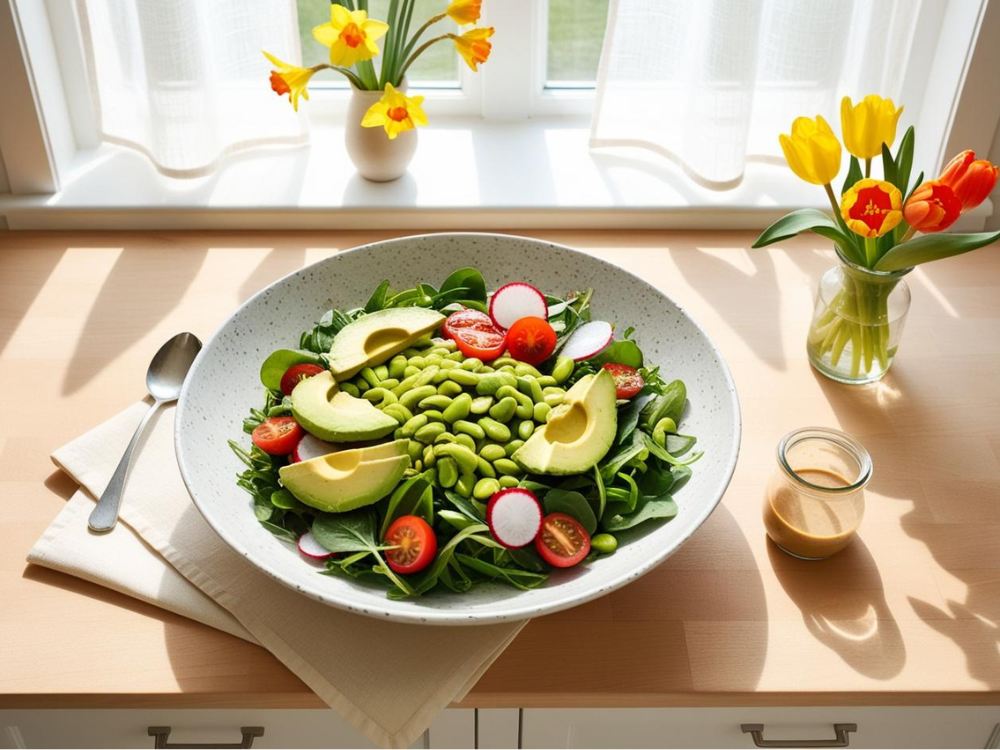Roasted Veggie and Hummus Wraps

Discover the Perfect Balance of Flavor and Nutrition in These Wraps
Looking for a healthy, flavorful, and satisfying meal that’s perfect for lunch or a light dinner? These Roasted Veggie and Hummus Wraps are a match made in foodie heaven! Packed with vibrant roasted vegetables, creamy hummus, and wrapped in a soft tortilla, this dish is not only nutritious but also incredibly easy to customize. Whether you’re meal prepping for the week or whipping up a quick bite, these wraps are sure to satisfy your cravings.
Why choose this recipe? It’s a perfect balance of textures and flavors—smoky roasted veggies, tangy hummus, and fresh greens come together in a wrap that’s as good for your taste buds as it is for your body. Plus, it’s vegan-friendly, packed with fiber, and loaded with nutrients.
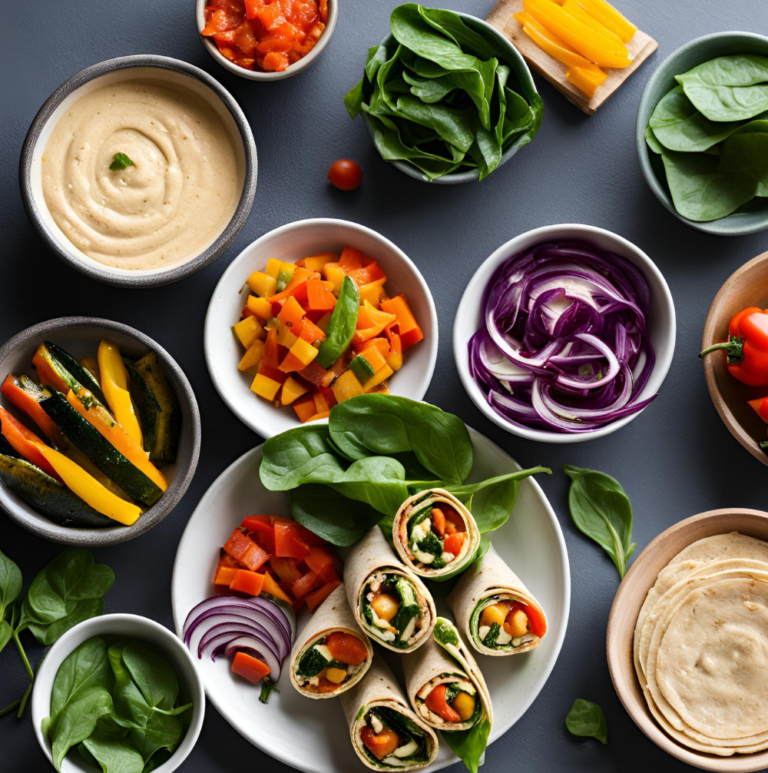
Nutritional Information: Roasted Veggie and Hummus Wraps
These Roasted Veggie and Hummus Wraps are not just delicious—they’re a powerhouse of nutrients that make them a fantastic choice for a healthy meal. Here’s the approximate nutritional breakdown per wrap (based on standard ingredients and quantities listed):
Per Serving (1 Wrap):
- Calories: 320
- Protein: 8g
- Carbohydrates: 42g
- Fiber: 8g
- Sugar: 6g
- Fat: 13g
- Saturated Fat: 2g
- Cholesterol: 0mg
- Sodium: 450mg
- Vitamin A: 35% of Daily Value (DV)
- Vitamin C: 70% of DV
- Calcium: 6% of DV
- Iron: 12% of DV
Key Nutritional Benefits:
- High in Fiber: Thanks to the fresh vegetables and whole-grain tortilla, these wraps support healthy digestion and keep you full longer.
- Rich in Vitamins and Antioxidants: Packed with Vitamin C from bell peppers and Vitamin A from spinach, these wraps help boost immunity and promote healthy skin.
- Plant-Based Protein: Hummus provides a good source of protein while keeping the recipe vegan-friendly.
- Healthy Fats: The olive oil and optional avocado contribute heart-healthy monounsaturated fats.
- Low in Saturated Fat: These wraps are light and heart-friendly, with minimal saturated fats.
Adjusting for Your Diet:
- For Lower Calories: Use a low-calorie wrap or lettuce leaves instead of tortillas.
- For Higher Protein: Add grilled tofu, tempeh, or chickpeas for an extra protein boost.
- For Gluten-Free Diets: Swap the tortilla for a certified gluten-free option.
This nutritional information is an estimate and may vary depending on specific ingredients or brands used. Always check your own ingredient labels if you need precise data.
Eat healthy, feel amazing, and enjoy every bite of these Roasted Veggie and Hummus Wraps!
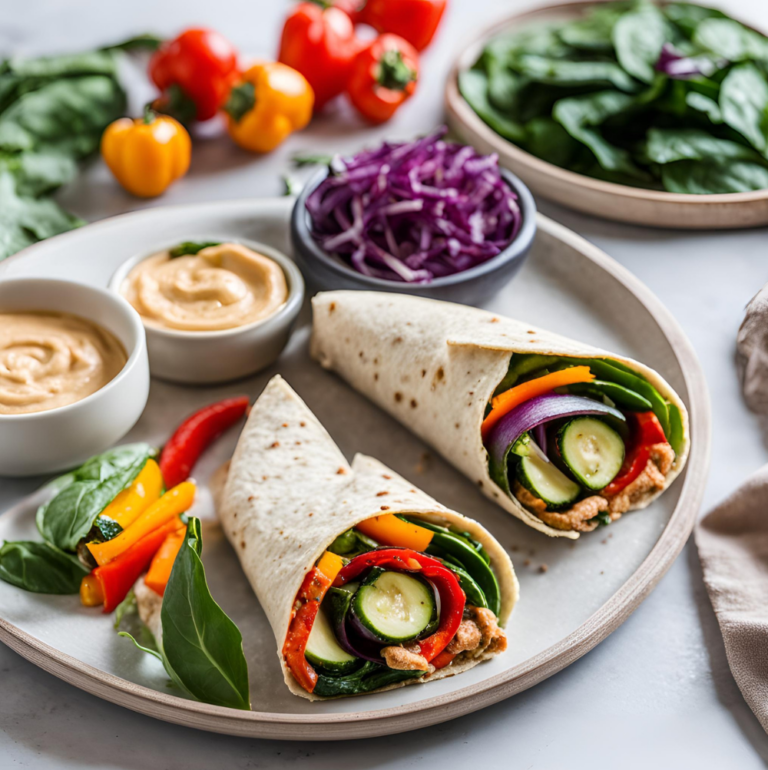
7 Best Tortilla Options for Delicious Wraps
When it comes to creating the perfect Roasted Veggie and Hummus Wraps, choosing the right tortilla is just as important as the filling. The tortilla acts as the foundation, keeping everything together and adding its own flavor and texture to the meal. With so many options available, here’s a guide to help you pick the best tortilla for your wraps.
1. Whole Wheat Tortillas
Whole wheat tortillas are a popular choice for health-conscious eaters. They are high in fiber, contain more nutrients than regular flour tortillas, and have a slightly nutty flavor that pairs beautifully with roasted vegetables and hummus. Look for tortillas labeled “100% whole wheat” for the healthiest option.
Best For: Those seeking a hearty, nutritious wrap.
2. Gluten-Free Tortillas
For those with gluten sensitivities or celiac disease, gluten-free tortillas are an excellent alternative. These tortillas are often made from ingredients like rice flour, almond flour, or cassava flour. They tend to be softer and more delicate, so handle them carefully to avoid tearing.
Best For: Individuals with dietary restrictions or gluten-free eaters.
3. Spinach Tortillas
Add a splash of color and extra nutrients to your wraps with spinach tortillas. Made with spinach puree, these tortillas have a mild flavor and are a fun way to sneak in some extra veggies. They’re also visually appealing, making your wraps Instagram-ready!
Best For: Those looking to add extra greens and a pop of color.
4. Low-Carb Tortillas
Low-carb tortillas, often made with almond flour or flaxseeds, are perfect for those following a keto or low-carb lifestyle. Despite their lower carbohydrate content, they hold up well and provide a neutral flavor that lets your fillings shine.
Best For: Keto enthusiasts or those monitoring their carb intake.
5. Flour Tortillas
The classic choice for wraps, flour tortillas are soft, flexible, and easy to work with. While they aren’t the healthiest option, their neutral flavor makes them a favorite for those prioritizing taste and convenience.
Best For: Traditionalists or those who prefer a soft, pliable wrap.
6. Corn Tortillas
Corn tortillas offer a slightly chewy texture and a distinct corn flavor. While they’re more commonly used for tacos, they can be a unique choice for wraps if you’re looking for a gluten-free and lower-calorie option.
Best For: Smaller wraps or those who enjoy a traditional, earthy taste.
7. Homemade Tortillas
If you’re feeling adventurous, homemade tortillas can take your wraps to the next level. Whether you make flour, corn, or gluten-free tortillas, the freshness and flavor are unmatched.
Best For: Home cooks who want complete control over ingredients and taste.
What to Look for in a Tortilla
- Size: Choose a tortilla large enough to hold your fillings but not so big that it becomes hard to handle.
- Flexibility: A good wrap tortilla should bend easily without cracking or tearing.
- Ingredients: For the healthiest choice, look for tortillas made with whole grains and minimal additives.
Pro Tips for Working with Tortillas
- Warm Them Up: Heat your tortillas in a skillet or microwave for a few seconds to make them more pliable.
- Store Properly: Keep tortillas in an airtight bag or container to prevent them from drying out.
- Layer Carefully: Place a layer of hummus or greens directly on the tortilla before adding heavier ingredients to prevent sogginess.
Choosing the right tortilla can elevate your Roasted Veggie and Hummus Wraps from good to amazing. Whether you go for a hearty whole wheat option, a vibrant spinach wrap, or a low-carb alternative, there’s a tortilla to suit every preference and dietary need.
Which tortilla is your favorite? Share your thoughts in the comments or tag us with #SatisfyYourCravings to show off your wrap creations!
Try some of our other recipes!
How to Meal Prep Roasted Veggie and Hummus Wraps Like a Pro
Making delicious and nutritious meals during a hectic week can feel challenging, but with a little preparation, your Roasted Veggie and Hummus Wraps can be ready to grab and go. Follow these meal prep tips to save time, stay organized, and enjoy fresh, flavorful wraps all week long.
1. Prep Your Veggies in Advance
- Wash and Chop Ahead of Time: Wash, chop, and store your vegetables in airtight containers. This makes it easy to season and roast them whenever you need.
- Roast in Batches: Roast a large batch of vegetables on Sunday or your designated meal prep day. Let them cool completely before storing them in airtight containers in the fridge for up to 5 days.
2. Make Your Hummus Ahead
- Homemade or Store-Bought: If you’re making hummus at home, prepare it in advance and store it in an airtight container in the fridge for up to a week.
- Flavor Variations: Make multiple hummus flavors (e.g., roasted red pepper or garlic) to add variety to your wraps throughout the week.
3. Store Components Separately
- Avoid Soggy Wraps: Keep your roasted veggies, hummus, greens, and tortillas stored separately until you’re ready to assemble. This keeps everything fresh and prevents your wraps from becoming soggy.
- Use Airtight Containers: Store each ingredient in its own container to maintain freshness. Glass containers are ideal as they help retain flavor and allow you to see what’s inside.
4. Pre-Portion for Convenience
- Tortillas and Fillings: Measure out portions of vegetables, hummus, and greens for each wrap. This way, you can quickly assemble your wraps without needing to measure ingredients every time.
- Grab-and-Go Packs: Pre-portion fillings into reusable containers or bento boxes for easy assembly at work or school.
5. Assemble Just Before Eating
- Keep It Fresh: Assemble the wraps when you’re ready to eat to maintain the best texture and flavor. This prevents the greens from wilting and the tortilla from becoming soggy.
6. Freeze for Long-Term Storage
- Wrap and Freeze: If you want to prepare wraps in advance, assemble them without the greens (to avoid wilting), wrap them tightly in foil, and freeze. To reheat, thaw in the fridge overnight and warm in a skillet or microwave.
- Best for Quick Lunches: Frozen wraps are ideal for busy mornings when you don’t have time to prep.
7. Invest in the Right Tools
- Storage Essentials: Use high-quality, airtight containers, reusable silicone bags, and sturdy lunchboxes to keep everything fresh and portable.
- Tortilla Warmers: If you like warm wraps, a microwaveable tortilla warmer can make lunchtime a breeze.
8. Plan a Wrap Bar for Variety
- Set Up a DIY Wrap Bar: Lay out your roasted veggies, hummus, greens, and any extra toppings like avocado, pickles, or feta cheese. Everyone in your household can customize their own wrap for the day ahead.
- Switch It Up: Rotate your veggie selection each week to keep your wraps exciting and flavorful.
9. Double Up for Other Meals
- Reimagine Leftovers: Use leftover roasted veggies in salads, grain bowls, or pasta dishes to reduce waste and add variety to your weekly menu.
Quick Assembly Hack
- Layer Order: Start with hummus spread on the tortilla, followed by greens, roasted veggies, and optional toppings. Roll tightly, and you’re good to go!
Meal prepping for busy weekdays doesn’t have to be overwhelming. With a little organization and these tips, you can enjoy healthy, delicious Roasted Veggie and Hummus Wraps every day with minimal effort.
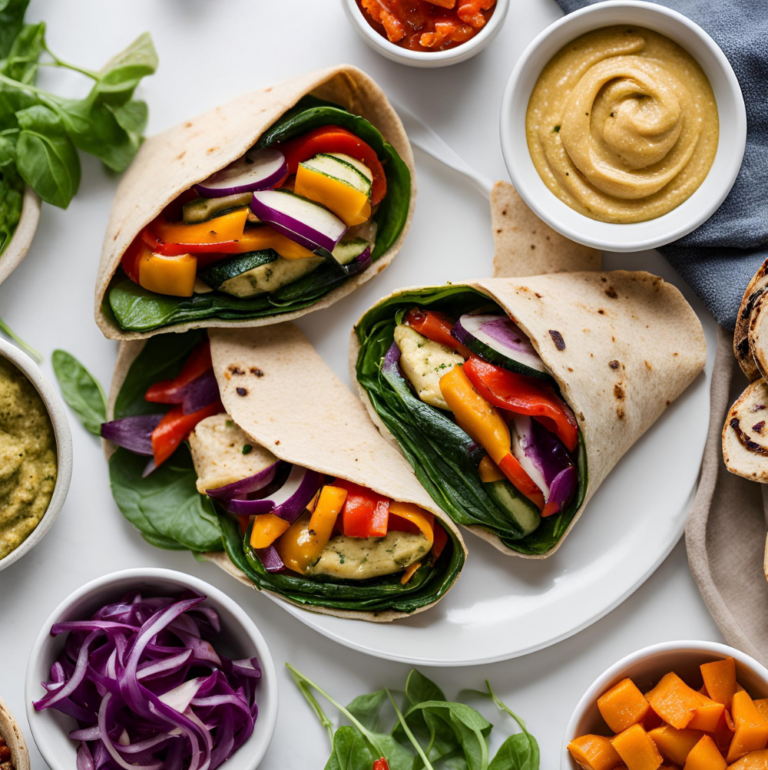
Kid-Approved Veggie Wraps Your Little Ones Will Love
Getting kids to enjoy vegetables can be tricky, but these Kid-Friendly Roasted Veggie Wraps are a fun and delicious way to sneak in the good stuff! By tailoring the ingredients to appeal to young taste buds and adding interactive assembly, you can turn this recipe into a meal your kids will love.
1. Choose Mild and Sweet Vegetables
Not all kids love the strong flavors of certain roasted vegetables. Stick to sweeter, milder options like:
- Carrots (cut into sticks or coins)
- Sweet bell peppers (red, yellow, or orange)
- Cherry tomatoes (halved)
- Sweet potatoes (cubed)
- Zucchini (sliced into thin sticks)
These veggies caramelize beautifully when roasted, adding a natural sweetness that kids enjoy.
2. Adjust the Seasoning
Skip spices like cumin or paprika, which might be too strong for kids, and stick to simple seasoning:
- Olive oil
- A light sprinkle of salt
- A dash of garlic powder (optional)
3. Add a Kid-Approved Spread
While hummus is a healthy and tasty choice, some kids may prefer something milder or more familiar. Try:
- Cream cheese (plain or flavored)
- A light layer of ranch dressing
- Mashed avocado
For adventurous eaters, stick with classic hummus or even a roasted red pepper variety for added sweetness.
4. Incorporate Familiar Favorites
Add ingredients that your kids already love to make the wraps more appealing:
- Shredded cheese (cheddar, mozzarella, or a mild blend)
- Sliced deli turkey or chicken for extra protein
- A sprinkle of crispy bacon bits
5. Use Smaller Tortillas
Opt for mini or taco-sized tortillas that are easier for little hands to hold and eat. Whole wheat or flour tortillas are usually the most kid-friendly choices.
6. Let Them Build Their Own Wrap
Kids are more likely to eat a meal they’ve helped prepare! Create a “wrap bar” with the ingredients in small bowls and let your little ones:
- Choose their veggies
- Spread their favorite dip or hummus
- Add cheese or protein
- Roll up their own wrap
7. Turn It Into Pinwheels
For younger kids or picky eaters, transform the wraps into fun pinwheels:
- Assemble the wrap as usual, then roll it tightly.
- Slice into 1-inch thick rounds.
- Secure with toothpicks (optional) for easy handling.
These bite-sized pieces are visually appealing and perfect for lunchboxes or snacks.
8. Serve with Kid-Friendly Sides
Pair the wraps with sides kids love to round out the meal:
- Fresh fruit (grapes, apple slices, or berries)
- Yogurt cups
- Veggie sticks with ranch or hummus for dipping
- Whole-grain crackers
Why Kids Will Love It
This version of Roasted Veggie Wraps is fun, customizable, and full of familiar flavors. Plus, the interactive assembly makes it feel like a mini DIY project!
Encourage your kids to get creative and make the wraps their own. It’s a simple way to turn healthy eating into a fun family activity.
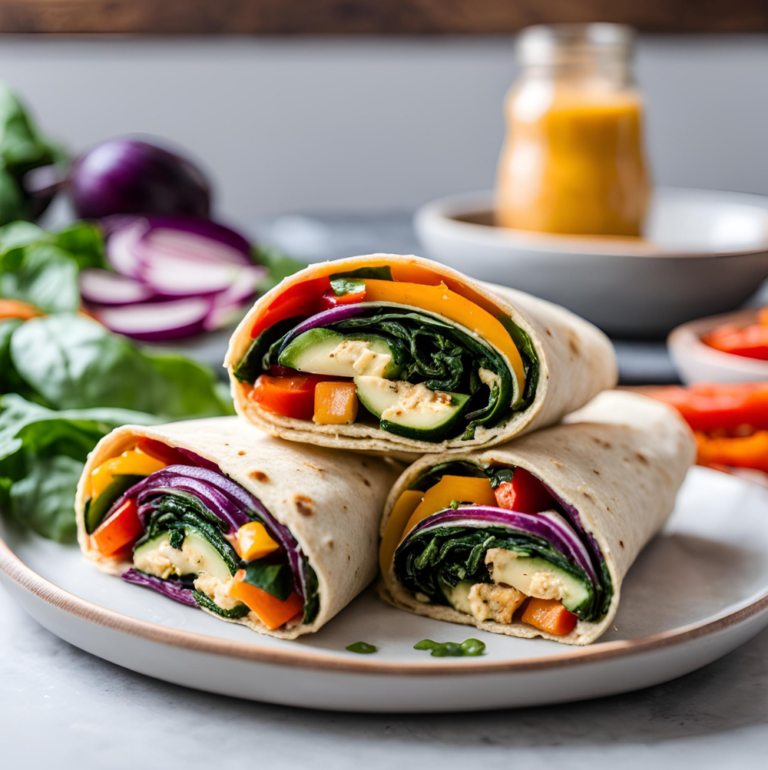
Love Bowls? Here’s How to Turn Your Wrap into One
Love the idea of Roasted Veggie and Hummus Wraps but prefer your meals in a bowl? No problem! Transforming this recipe into a vibrant, satisfying bowl is easy and perfect for those looking for a gluten-free option or a fresh presentation. Here’s how to create a delicious, deconstructed version of this wrap.
1. Start with a Base
Choose a hearty, flavorful base to anchor your bowl. Some great options include:
- Greens: Baby spinach, arugula, kale, or mixed greens for a light and fresh base.
- Grains: Quinoa, brown rice, couscous, or farro for a more filling option.
- Low-Carb Alternative: Cauliflower rice or spiralized zucchini for a lighter choice.
2. Add Your Roasted Veggies
Top your base with a generous portion of the roasted vegetables from the wrap recipe. Their caramelized flavor will stand out beautifully in a bowl.
3. Incorporate Hummus
Instead of spreading the hummus on a tortilla, use it as a creamy, flavorful topping or dip:
- Dollop It: Add a scoop of hummus to the center of the bowl.
- Drizzle It: Thin the hummus with a little water or lemon juice to create a creamy dressing and drizzle it over the bowl.
4. Add Extra Toppings
Customize your bowl with toppings to enhance flavor, texture, and nutrition:
- Crunchy Options: Toasted nuts, seeds (like sunflower or pumpkin), or crispy chickpeas.
- Creamy Additions: Avocado slices, crumbled feta, or a soft-boiled egg.
- Herbs and Garnishes: Fresh parsley, cilantro, or a sprinkle of smoked paprika for added flair.
5. Finish with a Dressing
If you want a little extra moisture, drizzle your bowl with a tangy dressing or olive oil. Lemon-tahini dressing pairs particularly well with the flavors in this recipe.
6. Serve and Enjoy
Arrange your ingredients in sections or mix them all together—either way, you’ll have a flavorful, colorful bowl that’s as delicious as it is Instagram-worthy!
Why Turn It Into a Bowl?
- Gluten-Free Friendly: Perfect for those avoiding tortillas or bread.
- Customizable: Easily adjust portions and toppings to fit your preferences or dietary needs.
- Perfect for Meal Prep: Bowls are easy to portion and store, making them ideal for meal prepping lunches or dinners.
Transforming these wraps into a bowl is a fantastic way to enjoy the same delicious flavors in a fresh, new format.
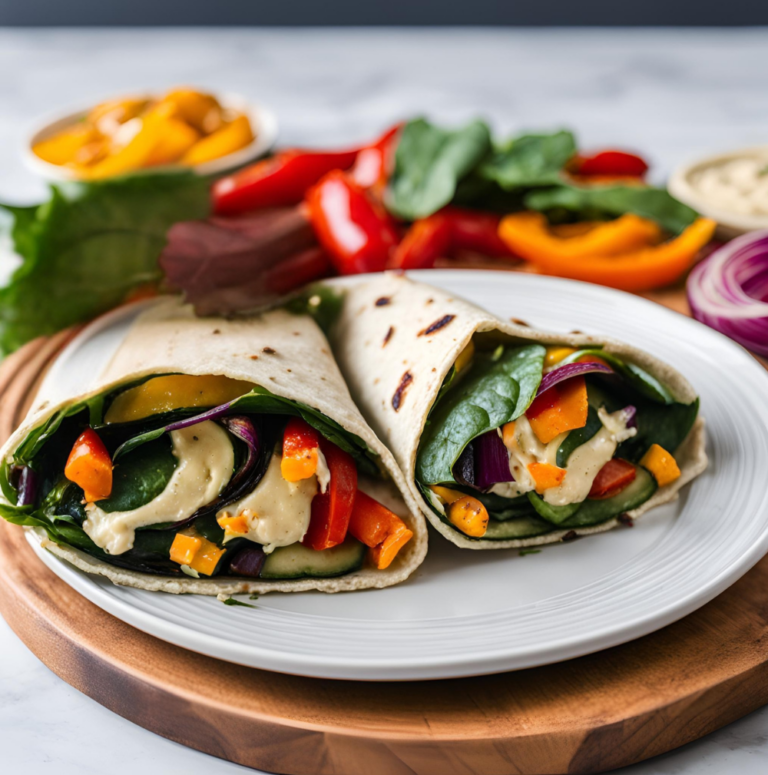
Wraps Around the World: Global Flavor Inspirations
Wraps are a universal comfort food, enjoyed in countless forms across the globe. From spicy street food to wholesome family meals, each culture brings its own unique ingredients and techniques to this versatile dish. Let’s explore how you can draw inspiration from wraps around the world to elevate your Roasted Veggie and Hummus Wraps into an international culinary adventure.
1. Mediterranean-Style Wraps
Inspired by the flavors of Greece and the Middle East, these wraps are bursting with fresh, tangy, and savory ingredients:
- Additions: Olives, crumbled feta, sun-dried tomatoes, or a drizzle of tzatziki.
- Spices: Sprinkle sumac, oregano, or za’atar on your roasted veggies for an authentic touch.
- Base: Use a soft pita instead of a tortilla for a traditional Mediterranean feel.
2. Mexican-Inspired Wraps
Transform your wrap with the bold, spicy flavors of Mexico:
- Additions: Black beans, corn, fresh salsa, avocado slices, and shredded cheese.
- Spices: Add chili powder, cumin, or a splash of lime juice for zest.
- Base: Swap the tortilla for a large, soft flour tortilla or a corn-based one for authenticity.
3. Asian Fusion Wraps
For an Asian twist, infuse your wrap with savory, umami-rich ingredients:
- Additions: Thinly sliced cucumber, shredded carrots, pickled radish, and fresh cilantro.
- Sauces: Drizzle with peanut sauce, soy-based dressing, or a spicy sriracha mayo.
- Base: Use a rice paper wrap or a thin crepe for a lighter, fresher option.
4. Indian-Inspired Wraps
Bring the warm and aromatic flavors of India to your wrap:
- Additions: Roasted cauliflower, spiced chickpeas, and a dollop of cooling yogurt or raita.
- Spices: Season your veggies with garam masala, turmeric, or cumin.
- Base: Use a naan or roti for an authentic Indian flatbread experience.
5. Middle Eastern Shawarma-Style Wraps
Inspired by the popular street food, shawarma wraps are rich, tangy, and packed with bold flavors:
- Additions: Pickled vegetables, garlic sauce, tahini drizzle, and a sprinkle of fresh parsley.
- Spices: Use a shawarma spice blend or add a hint of cinnamon and allspice to your roasted veggies.
- Base: Serve in a warm flatbread or thin pita for an authentic texture.
6. Korean-Inspired Wraps
Bring a burst of Korean flavor to your wraps with bold, spicy, and tangy notes:
- Additions: Kimchi, shredded cabbage, and a fried egg for richness.
- Sauces: Add gochujang (Korean chili paste) or sesame soy dressing for a punch of umami.
- Base: Use lettuce leaves or a thin tortilla to keep it light.
7. Italian-Inspired Wraps
Channel the comforting flavors of Italy with fresh ingredients and bold seasonings:
- Additions: Sautéed zucchini, roasted red peppers, mozzarella, and fresh basil leaves.
- Sauces: Drizzle with balsamic glaze or a dollop of pesto for authentic Italian flair.
- Base: A thin focaccia or spinach wrap works beautifully.
8. Caribbean-Style Wraps
Infuse your wraps with the vibrant, tropical flavors of the Caribbean:
- Additions: Jerk-spiced veggies, sweet plantains, mango salsa, and a touch of fresh lime.
- Spices: Use jerk seasoning or allspice to capture the island flavors.
- Base: Use a flour tortilla or roti for an authentic Caribbean touch.
How to Incorporate Global Flavors
- Mix and Match: Don’t be afraid to combine elements from different cuisines to create your own fusion wrap.
- Experiment with Spices: Many global wraps rely on unique spice blends that can be added to roasted veggies for an instant flavor boost.
- Add Regional Sauces: Incorporating traditional sauces like tzatziki, peanut sauce, or gochujang can instantly transform your wrap.
Wraps are an incredibly versatile dish, and the global possibilities are endless. Take your Roasted Veggie and Hummus Wraps to new heights by experimenting with these international inspirations. What’s your favorite global twist on a wrap? Share your creations with us on social media using #SatisfyYourCravings!
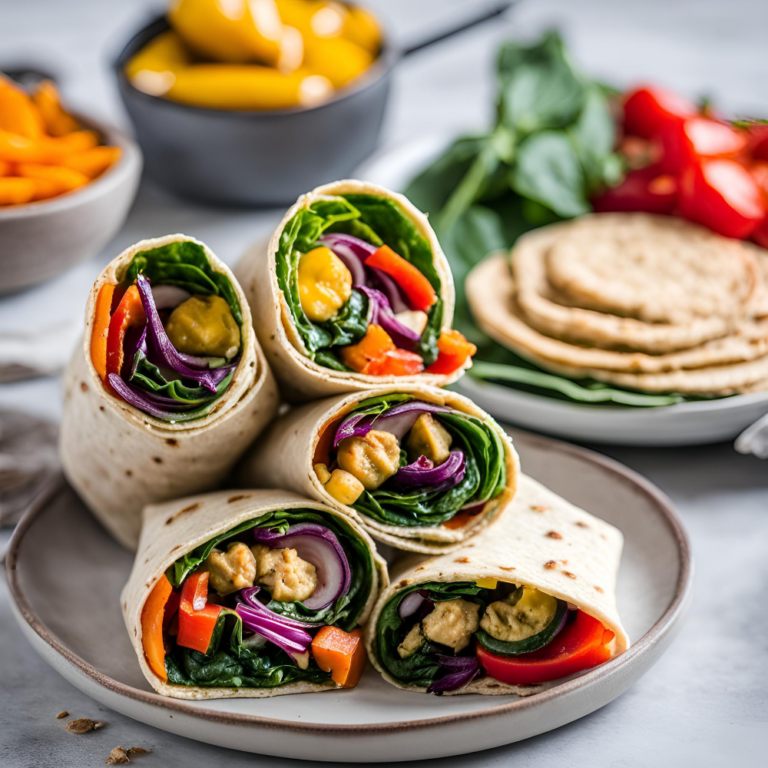
How to Add a Crunch to Your Wraps
The key to an unforgettable wrap lies in the combination of textures, and adding a bit of crunch can take your Roasted Veggie and Hummus Wraps to the next level. Whether you prefer a subtle crisp or a bold crunch, here are some easy and flavorful ways to add texture to your wraps.
1. Crispy Veggies
Raw vegetables are a simple, healthy way to add crunch to your wraps:
- Cucumbers: Thinly sliced or julienned for a refreshing snap.
- Carrots: Shredded or cut into matchsticks for a sweet crunch.
- Bell Peppers: Add vibrant color and a juicy crispness.
- Red Cabbage: Shredded for a mild flavor and crunchy texture.
2. Crunchy Greens
Swap soft greens like spinach for crisp varieties to enhance texture:
- Romaine Lettuce: Adds a fresh, crisp bite to every wrap.
- Iceberg Lettuce: Perfect for a neutral crunch without overpowering other flavors.
- Shredded Kale: Massage the leaves lightly to retain some crunch while softening the edges.
3. Toasted Nuts and Seeds
A sprinkle of toasted nuts or seeds can add crunch and a boost of nutrients:
- Sunflower Seeds: Mild and nutty, they pair perfectly with roasted veggies.
- Pumpkin Seeds: Add a satisfying crunch and earthy flavor.
- Sliced Almonds: Toast them lightly for a delicate, nutty crunch.
- Sesame Seeds: Sprinkle for a subtle, crunchy finish.
4. Crispy Chickpeas
Roasted chickpeas are a protein-packed way to add crunch:
- Toss chickpeas with olive oil, smoked paprika, garlic powder, and a pinch of salt. Roast at 400°F (200°C) for 20–30 minutes until crispy.
- Use them as a topping or mix them directly into the wrap for added texture.
5. Crushed Tortilla Chips or Crackers
For a fun and unexpected crunch, try crushed tortilla chips or crackers:
- Tortilla Chips: Add a Tex-Mex twist with crumbled tortilla chips.
- Whole-Grain Crackers: Crush them lightly for a healthier, crunchy topping.
- Pita Chips: Perfect for a Mediterranean vibe.
6. Pickled Veggies
Pickled vegetables not only add crunch but also a tangy flavor:
- Pickled Red Onions: Crisp and zesty with a slight sweetness.
- Cucumber Pickles: Classic and kid-friendly for a satisfying crunch.
- Kimchi: For a bold, spicy crunch with an Asian flair.
7. Crispy Add-Ons
Don’t forget these quick and easy crispy options:
- Bacon Bits: Add a smoky crunch for a non-vegetarian twist.
- Fried Onions or Shallots: Crispy and savory, they complement the hummus perfectly.
- Crunchy Granola: For an unconventional but tasty sweet-and-savory element.
8. Toasted Tortilla or Wrap
Give your entire wrap a crunchy edge by toasting it:
- Heat your assembled wrap in a dry skillet over medium heat for 2–3 minutes on each side until golden and crisp.
- Alternatively, grill it lightly for added flavor and crunch.
Pro Tips for the Perfect Crunch
- Layer Thoughtfully: Place crunchy ingredients on top of the hummus or greens to prevent them from getting soggy.
- Balance Textures: Pair crunchy ingredients with creamy ones like hummus or avocado for a satisfying contrast.
- Customize to Taste: Mix and match crunchy add-ons to suit your personal preferences and the flavor profile of your wrap.
Adding a bit of crunch transforms your Roasted Veggie and Hummus Wraps into a textural delight. What’s your favorite way to add crunch?
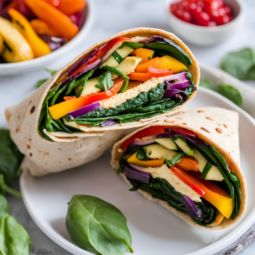
Roasted Veggie and Hummus Wraps
Equipment
- 1 Cutting Board: For chopping vegetables.
- 1 Chef’s Knife – To slice and dice veggies with ease.
- 1 Baking Sheet – For roasting the vegetables.
- Parchment Paper or Silicone Baking Mat – To prevent sticking and make cleanup easier.
- 1 Mixing Bowl – For tossing the vegetables with oil and seasonings.
- Measuring Spoons – To measure spices and olive oil.
- 1 Spatula or Tongs – For stirring the veggies during roasting.
- 1 Nonstick Skillet (Optional) – To warm the tortillas or wraps.
- 1 Spoon or Spreader – To evenly spread hummus on the wraps.
- Serving Plates – For assembling and serving the wraps.
Ingredients
For the Roasted Vegetables
- 1 Medium zucchini, sliced
- 1 Red bell pepper, sliced
- 1 Yellow bell pepper, sliced
- 1 Red onion, sliced
- 1 cup Cherry tomatoes
- 2 tbsp Olive oil
- 1 tsp Smoked paprika
- 1 tsp Garlic powder
- ½ tsp Cumin
- Salt and pepper, to taste
For the Wraps:
- 4 Large tortillas or wraps
- 1 cup Hummus (store-bought or homemade)
- 2 cups Fresh spinach or mixed greens
- ½ Avocado, sliced (optional)
- 1 tbsp Lemon juice
Instructions
Step 1: Prep the Vegetables
- Preheat your oven to 400°F (200°C).
- Line a baking sheet with parchment paper or a silicone mat for easy cleanup.
- In a large bowl, toss the zucchini, bell peppers, onion, and cherry tomatoes with olive oil, smoked paprika, garlic powder, cumin, salt, and pepper.
Step 2: Roast the Vegetables
- Spread the seasoned vegetables evenly on the prepared baking sheet.
- Roast for 20–25 minutes, stirring halfway through, until the vegetables are tender and slightly caramelized.
Step 3: Assemble the Wraps
- Warm the tortillas in a dry skillet or microwave for a few seconds to make them pliable.
- Spread about ¼ cup of hummus evenly over each tortilla.
- Layer fresh spinach or mixed greens on top of the hummus.
- Add a generous scoop of roasted vegetables and a few slices of avocado. Drizzle with lemon juice for a burst of freshness.
Step 4: Wrap It Up!
- Fold the sides of the tortilla inward, then roll it up tightly from the bottom.
- Slice in half if desired, and serve immediately.
Notes
How to Store and Reheat Your Wraps
Whether you’re meal prepping for the week or saving leftovers, knowing how to properly store and reheat your Roasted Veggie and Hummus Wraps ensures they stay fresh, flavorful, and ready to enjoy. Here’s how to store and reheat your wraps like a pro!1. Storing Assembled Wraps
If you’ve already assembled your wraps, follow these steps to keep them fresh:- Wrap Individually: Tightly wrap each assembled wrap in parchment paper or foil to maintain its shape and prevent spills.
- Airtight Container: Place the wrapped wraps in an airtight container or resealable plastic bag to keep them fresh and prevent them from drying out.
- Refrigeration: Store in the fridge for up to 2–3 days. For best results, avoid adding greens like spinach to assembled wraps until you’re ready to eat, as they can wilt over time.
2. Storing Ingredients Separately
If you plan to assemble your wraps just before eating, store the ingredients individually:- Roasted Vegetables: Transfer cooled roasted veggies to an airtight container and refrigerate for up to 5 days.
- Hummus: Store hummus in a sealed container in the fridge for up to 1 week.
- Tortillas: Keep tortillas in their original packaging or in a resealable bag to prevent them from drying out.
3. Freezing Wraps
Freezing wraps is a great option for long-term storage:- Pre-Assemble Without Greens: Prepare the wraps without adding greens or other ingredients that don’t freeze well.
- Wrap Securely: Wrap each wrap tightly in plastic wrap, followed by a layer of aluminum foil to prevent freezer burn.
- Freezing Time: Store in the freezer for up to 3 months.
- Label and Date: Add a label with the date so you can keep track of freshness.
4. Reheating Your Wraps
Reheating your wraps correctly is key to maintaining their flavor and texture. Here’s how: From the Refrigerator:- Microwave: Unwrap the foil or parchment paper, place the wrap on a microwave-safe plate, and microwave for 30–60 seconds, or until warmed through.
- Skillet: Heat a dry skillet over medium heat and warm the wrap for 2–3 minutes on each side until it’s heated and lightly crisped.
- Thaw Overnight: For best results, transfer frozen wraps to the fridge to thaw overnight before reheating.
- Microwave: Remove the foil and microwave for 1–2 minutes, checking halfway to ensure even heating.
- Oven: Preheat the oven to 350°F (175°C). Place the wrap on a baking sheet and heat for 10–12 minutes, or until warmed through.
5. Tips for Best Results
- Add Fresh Greens Later: If you’re storing wraps for later, add greens like spinach or lettuce just before serving to keep them crisp and fresh.
- Don’t Overstuff: Overfilled wraps are harder to store and reheat evenly. Stick to moderate portions for easier handling.
- Crispiness Hack: For a crispier wrap, reheat in a skillet or oven instead of the microwave.
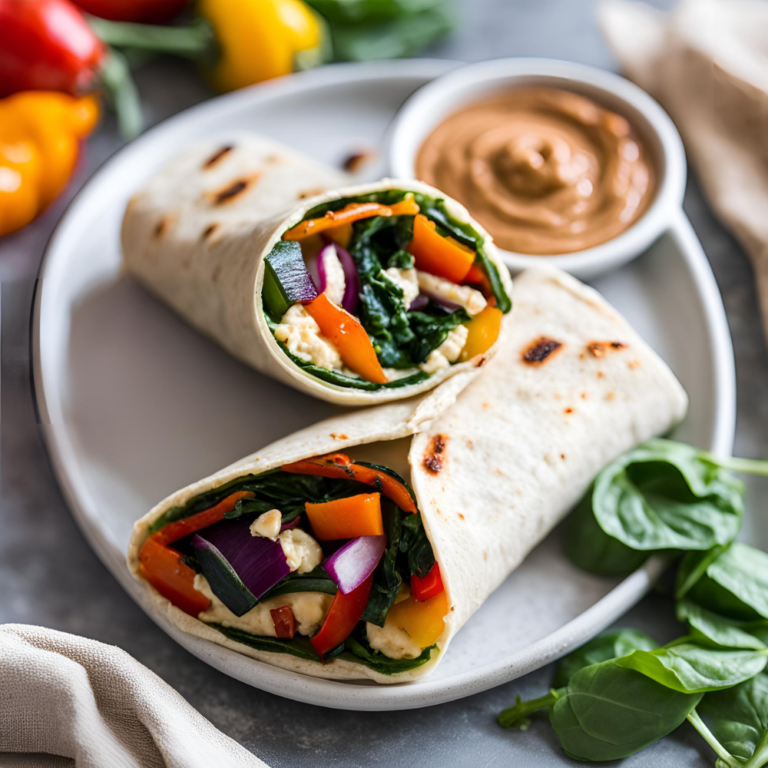
Vegan vs. Vegetarian: Making the Recipe Work for Both Diets
The beauty of Roasted Veggie and Hummus Wraps lies in their versatility. They’re naturally vegan, but with a few simple tweaks, they can also cater to vegetarian preferences or be customized for mixed-diet households. Here’s how to make this recipe work for both vegan and vegetarian lifestyles while keeping the flavors and textures satisfying for everyone.
What’s the Difference Between Vegan and Vegetarian?
- Vegan: Avoids all animal-derived products, including dairy, eggs, and honey.
- Vegetarian: Avoids meat, poultry, and fish but may include dairy, eggs, and other animal-derived ingredients.
Understanding these differences is key to adjusting recipes for each diet.
Making It Vegan
This recipe is already vegan-friendly, but here are some tips to ensure it meets all vegan standards:
1. Stick to Plant-Based Ingredients
- Hummus: Ensure your hummus is free from non-vegan additives like honey. Store-bought hummus is usually vegan, but check the label to confirm.
- Toppings: Use roasted veggies, fresh greens, avocado, and vegan-friendly add-ons like pickled onions or seeds.
2. Enhance Protein Options
To make the wrap more filling, include vegan protein sources such as:
- Crispy chickpeas
- Marinated tofu strips
- Tempeh or seitan slices
3. Vegan Dressings
If you want to add extra sauce, use plant-based options like tahini, avocado crema, or vegan ranch.
Adjusting for Vegetarians
To adapt the recipe for vegetarians who enjoy dairy or eggs, consider these options:
1. Add Cheese
Cheese can bring a creamy, tangy flavor that pairs beautifully with the roasted veggies. Try:
- Crumbled feta for a Mediterranean touch.
- Shredded mozzarella for a mild, melty option.
- Goat cheese for a rich and tangy flavor.
2. Include Eggs
For a protein boost, add eggs to the wrap:
- Hard-boiled slices for a hearty addition.
- Scrambled eggs for a soft, rich texture.
3. Yogurt-Based Sauces
Drizzle your wrap with a vegetarian-friendly yogurt dressing, such as:
- Tzatziki
- Lemon-dill yogurt sauce
Tips for Mixed-Diet Households
If you’re preparing these wraps for a group with both vegans and vegetarians, follow these tips to keep everyone happy:
Prep a Vegan Base
Start with the vegan version of the wrap (roasted veggies, hummus, and greens).Offer Toppings Buffet-Style
Set up a “wrap bar” with separate topping options like cheese, eggs, vegan proteins, and sauces. This allows everyone to customize their wrap according to their dietary needs.Label Ingredients Clearly
If serving buffet-style, label vegan and vegetarian toppings to make it easy for guests to choose.
Why This Recipe Works for Both Diets
- Customizable Base: The foundation of roasted veggies and hummus is naturally vegan and can be enjoyed as-is or built upon.
- Flavor Adaptability: Adding vegetarian or vegan toppings doesn’t compromise the original flavors, making it easy to satisfy all palates.
- Simple Adjustments: With just a few swaps or additions, the wraps can be tailored to suit either diet.
Whether you’re vegan, vegetarian, or cooking for a group with diverse preferences, these Roasted Veggie and Hummus Wraps are the perfect customizable meal.

Low-Calorie and High-Protein Wrap Variations
Whether you’re watching your calorie intake or aiming to boost your protein, these variations of Roasted Veggie and Hummus Wraps are tailored to meet your dietary goals without sacrificing flavor. With simple swaps and strategic ingredient choices, you can enjoy a delicious, healthy wrap that works for your lifestyle.
Low-Calorie Wrap Variations
Cutting calories doesn’t mean cutting flavor! Here’s how to create a lighter version of this wrap:
Choose a Low-Calorie Base
- Opt for low-calorie tortillas (under 100 calories each). Look for whole-grain or low-carb options for added fiber.
- Use lettuce wraps (like romaine or butter lettuce) or collard greens for a calorie-free alternative.
Use a Light Hummus
- Choose a store-bought low-fat hummus, or make your own using less tahini. You can also try blending cooked zucchini or cauliflower into the hummus for a lighter version.
Focus on Veggies
- Fill your wrap with low-calorie, nutrient-dense vegetables like cucumbers, bell peppers, zucchini, and spinach.
Skip Calorie-Dense Add-Ons
- Avoid extras like avocado or high-fat cheeses. Instead, use a splash of lemon juice or balsamic vinegar for added flavor.
Use Nonstick Cooking Methods
- Roast your veggies with minimal oil by using a nonstick baking sheet or an oil spray.
High-Protein Wrap Variations
Boosting protein can make your wraps more satisfying and suitable for post-workout meals. Here’s how to create a high-protein version:
Incorporate Protein-Rich Fillings
- Add grilled chicken or turkey slices for lean protein.
- For a plant-based option, include tempeh, tofu, or edamame.
- Add boiled eggs or egg whites for an extra protein kick.
Use a High-Protein Tortilla
- Many brands offer high-protein tortillas, often made with added legumes or flaxseeds, which can provide 10+ grams of protein per wrap.
Protein-Packed Hummus
- Blend cooked chickpeas with a scoop of unflavored plant-based protein powder when making homemade hummus.
Sprinkle on Extra Protein
- Add toasted seeds (like hemp, chia, or sunflower seeds) for a crunchy, protein-rich topping.
- Sprinkle on a little parmesan or crumbled feta for additional protein if you’re not vegan.
Use Greek Yogurt-Based Sauces
- Swap traditional hummus for a Greek yogurt tzatziki or a creamy yogurt-based dressing for fewer calories and more protein.
Combination: Low-Calorie, High-Protein Wraps
For the best of both worlds, combine strategies from both variations:
- Use lettuce wraps or low-calorie tortillas as your base.
- Add grilled tofu or chicken strips as your protein source.
- Fill with low-calorie veggies like cucumbers, bell peppers, and spinach.
- Add a drizzle of Greek yogurt-based dressing for flavor without excess fat.
Recipe Ideas for Inspiration
Mediterranean Low-Calorie Wrap
- Base: Lettuce wrap
- Filling: Roasted zucchini, tomatoes, cucumbers, and red onion
- Sauce: Light hummus with a squeeze of lemon
High-Protein Tex-Mex Wrap
- Base: High-protein tortilla
- Filling: Black beans, grilled chicken, roasted peppers, and spinach
- Sauce: Greek yogurt blended with lime and a touch of cumin
Low-Calorie Asian-Inspired Wrap
- Base: Collard green wrap
- Filling: Shredded carrots, edamame, cucumber, and tofu
- Sauce: Light soy dressing or peanut drizzle (in moderation)
High-Protein Breakfast Wrap
- Base: High-protein tortilla
- Filling: Egg whites, roasted veggies, and spinach
- Sauce: Greek yogurt tzatziki
Pro Tips
- Batch Prep: Roast a variety of low-calorie or high-protein fillings in advance to make weekday meals easier.
- Measure Ingredients: Keep track of portions, especially with calorie-dense foods like hummus or avocado.
- Experiment with Flavors: Use spices and herbs to add flavor without calories or fat.
By tailoring your wraps to be low-calorie, high-protein, or both, you can meet your dietary needs while still enjoying the satisfying flavors of Roasted Veggie and Hummus Wraps.
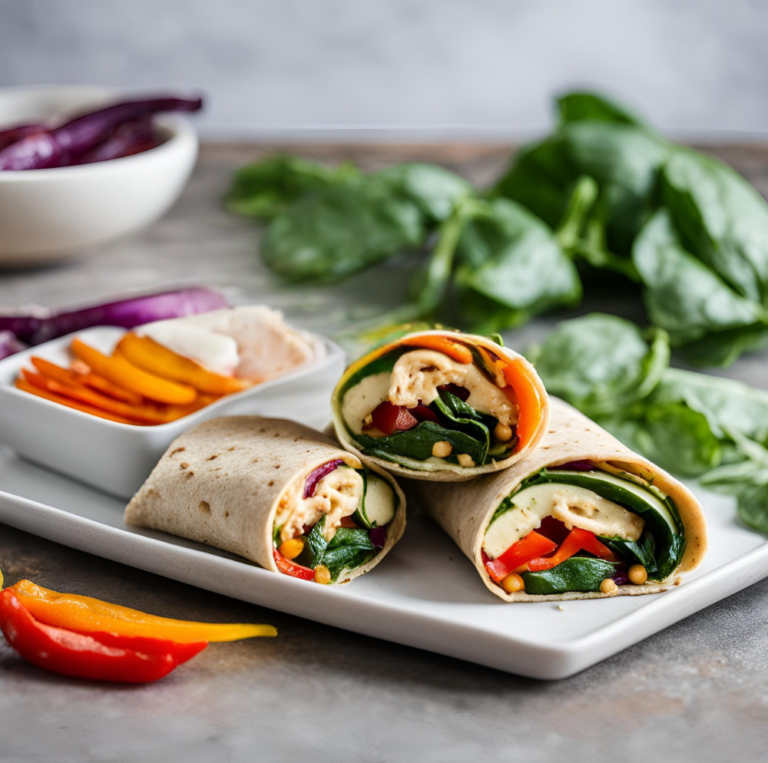
The Best Gluten-Free and Low-Carb Wrap Alternatives
For those following a gluten-free or low-carb diet, enjoying wraps doesn’t have to be off-limits! With creative alternatives and simple swaps, you can make Roasted Veggie and Hummus Wraps that are both delicious and diet-friendly. Here’s how to create gluten-free or low-carb wraps that are perfect for your lifestyle.
1. Gluten-Free Wrap Options
For a gluten-free version of this recipe, try these wrap alternatives:
Store-Bought Gluten-Free Tortillas
- Look for tortillas made from ingredients like almond flour, cassava flour, or coconut flour.
- Popular brands include Siete, Mission Gluten-Free, and Trader Joe’s gluten-free options.
Lettuce Wraps
- Use large, sturdy leaves of romaine lettuce, iceberg lettuce, or butter lettuce.
- These wraps are naturally gluten-free, refreshing, and low in calories.
Collard Green Wraps
- Collard greens are a durable and nutrient-packed alternative to tortillas.
- How to prep: Trim the thick stem and blanch the leaves in boiling water for 30 seconds to make them pliable.
Rice Paper Wrappers
- While slightly higher in carbs, rice paper is naturally gluten-free and works well for light, fresh wraps.
- Soften the wrappers in warm water before filling and rolling.
Homemade Gluten-Free Tortillas
- Make your own using almond flour, coconut flour, or chickpea flour for a soft, pliable tortilla.
- A simple recipe: Combine 1 cup almond flour, 2 tbsp psyllium husk, a pinch of salt, and ½ cup warm water. Roll out and cook in a skillet.
2. Low-Carb Wrap Options
For a low-carb version of this recipe, consider these alternatives:
Egg Wraps
- Use thin, crepe-like egg wraps made from beaten eggs or egg whites.
- Cook a thin layer of egg in a nonstick skillet, then use it as your wrap.
Coconut Wraps
- Made from coconut meat and coconut oil, these wraps are low in carbs and have a subtle sweetness.
- They pair especially well with roasted veggies and hummus.
Cheese Wraps
- Use pre-made cheese wraps (like Folios) or create your own by melting shredded cheese in a nonstick pan and letting it cool into a wrap.
Cauliflower Wraps
- Make or buy wraps made from cauliflower rice. They’re low in carbs, gluten-free, and perfect for a veggie-forward meal.
Zucchini Ribbons
- Use thinly sliced zucchini or cucumber to wrap your fillings.
- These are great for bite-sized or snack versions of your favorite wraps.
How to Assemble Gluten-Free or Low-Carb Wraps
- Choose Your Base: Pick a gluten-free or low-carb wrap that suits your preference.
- Layer Thoughtfully: Spread hummus or your preferred low-carb spread first to hold the ingredients together.
- Add Roasted Veggies: Place the roasted veggies and any additional toppings in the center of the wrap.
- Roll or Fold: Roll tightly or fold like a taco, depending on your wrap’s shape and flexibility.
Pro Tips for Success
- Prep Wraps Ahead: Wash and prepare lettuce, collard greens, or other wraps ahead of time to save time during assembly.
- Avoid Overfilling: Gluten-free and low-carb wraps can be delicate, so avoid overloading them with ingredients.
- Secure with Toothpicks: Use toothpicks or wrap in parchment paper to keep everything in place.
- Keep Them Fresh: Store prepped wraps in airtight containers to prevent drying out.
Why Choose Gluten-Free or Low-Carb Wraps?
- Health Benefits: Great for those managing gluten intolerance, celiac disease, or low-carb diets.
- Customizable: You can tailor your wrap to match dietary preferences without sacrificing flavor.
- Naturally Nutritious: Options like lettuce and collard greens add extra nutrients while keeping calories and carbs low.
By using these gluten-free or low-carb alternatives, you can enjoy the flavors of Roasted Veggie and Hummus Wraps while sticking to your dietary goals.

10 Delicious Variations for Roasted Veggie and Hummus Wraps
One of the best things about Roasted Veggie and Hummus Wraps is their versatility. You can easily customize them to suit your taste preferences, dietary needs, or the ingredients you have on hand. Here are some delicious variations to inspire your next wrap creation:
1. Protein-Packed Wraps
Add a boost of protein to make your wraps more filling:
- Plant-Based Proteins: Add crispy chickpeas, grilled tofu, tempeh, or black beans.
- Animal Proteins: Include grilled chicken, turkey slices, or hard-boiled eggs for a hearty meal.
2. Mediterranean Twist
Transform your wraps with bold Mediterranean flavors:
- Use roasted eggplant, zucchini, and cherry tomatoes.
- Add kalamata olives, crumbled feta cheese, and a drizzle of tzatziki sauce.
- Swap the tortilla for a soft pita or flatbread.
3. Spicy Tex-Mex Style
Give your wraps a Tex-Mex flair with zesty ingredients:
- Use roasted corn, black beans, and diced jalapeños.
- Top with avocado slices, salsa, and a sprinkle of shredded cheese.
- Add a drizzle of chipotle mayo or lime crema for extra flavor.
4. Asian-Inspired Wraps
Bring a burst of Asian flavors to your wraps:
- Include shredded carrots, cucumber ribbons, and pickled radish.
- Use a peanut sauce or hoisin drizzle as the spread.
- Swap the tortilla for rice paper wrappers for a fresh spring roll vibe.
5. Low-Carb and Gluten-Free Variations
For a lighter or gluten-free option:
- Use lettuce leaves, collard greens, or coconut wraps as a base.
- Focus on low-carb veggies like zucchini, spinach, and mushrooms.
- Add tahini or avocado crema as a creamy, low-carb spread.
6. Breakfast Wraps
Turn your wraps into a morning meal:
- Add scrambled eggs, roasted sweet potatoes, and sautéed spinach.
- Top with a sprinkle of cheese and a dollop of salsa or hot sauce.
- Use a whole-grain or high-protein tortilla for a breakfast-friendly option.
7. Sweet and Savory Fusion
Create a unique flavor profile with sweet and savory ingredients:
- Include roasted butternut squash, caramelized onions, and a drizzle of maple syrup.
- Add a handful of dried cranberries or pomegranate seeds for sweetness.
- Pair with a creamy goat cheese or a light drizzle of tahini.
8. Vegan Cheese Lover’s Wrap
For a creamy, cheesy vegan option:
- Add a layer of vegan cream cheese, cashew cheese, or a sprinkle of nutritional yeast.
- Pair with roasted red peppers, spinach, and caramelized onions.
9. Seasonal Variations
Adjust your wraps based on seasonal produce:
- Spring: Asparagus, radishes, and fresh herbs like dill and parsley.
- Summer: Grilled zucchini, eggplant, and juicy cherry tomatoes.
- Fall: Roasted sweet potatoes, brussels sprouts, and apples.
- Winter: Roasted root vegetables like carrots, parsnips, and beets.
10. Deconstructed Bowl
Turn your wrap into a bowl for a fun twist:
- Layer your hummus, roasted veggies, greens, and toppings in a bowl.
- Add grains like quinoa or rice for added texture.
- Drizzle with your favorite dressing or tahini sauce.
Why Try These Variations?
These ideas make it easy to keep your wraps exciting, whether you’re meal prepping, serving guests, or satisfying your own cravings. Experiment with different ingredients and flavors to find your new favorite combination!
What’s your favorite way to customize your wraps?
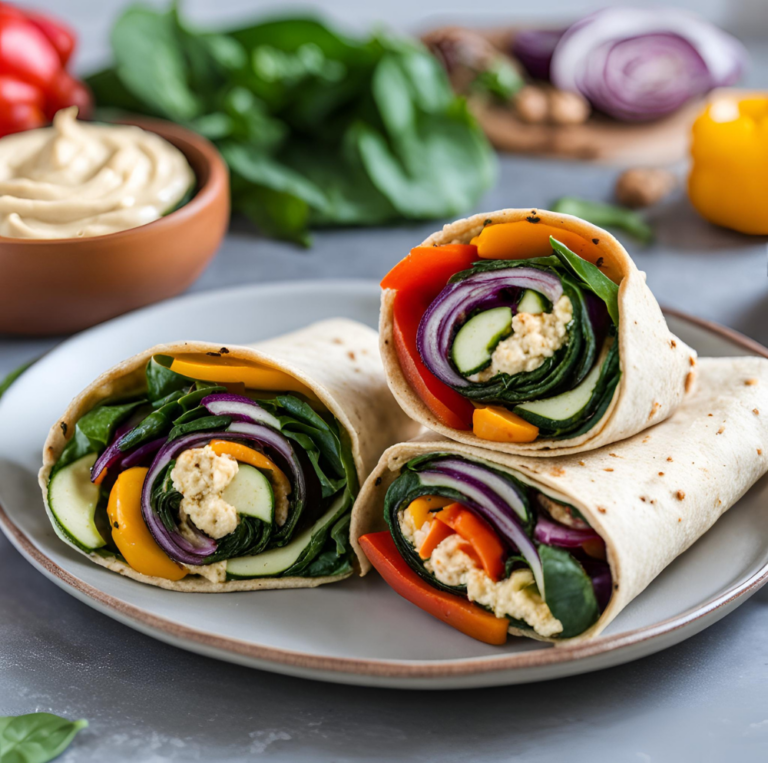
Healthy, Delicious, and Easy: Try These Roasted Veggie Wraps Today!
These Roasted Veggie and Hummus Wraps are not just a meal—they’re a celebration of wholesome ingredients and bold flavors. Whether you’re feeding your family or meal-prepping for the week, this recipe is as versatile as it is delicious.
So what are you waiting for? Gather your veggies, grab your favorite hummus, and whip up these wraps today! Don’t forget to share your creations with us on social media using the hashtag #SatisfyYourCravings. We’d love to see your spin on this recipe!
Join Now!
Love this recipe? Don’t miss out on even more delicious, healthy, and easy-to-make recipes like this! By joining our email community, you’ll gain access to exclusive content, bonus recipes, and tips to make healthy eating fun and effortless.
Enter your email & click below to subscribe and start receiving tasty inspiration right away. It only takes a minute to join our growing community of food lovers dedicated to clean and wholesome eating.

